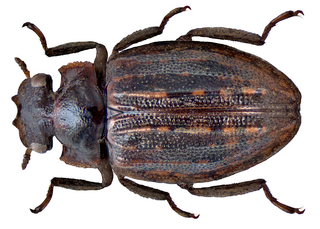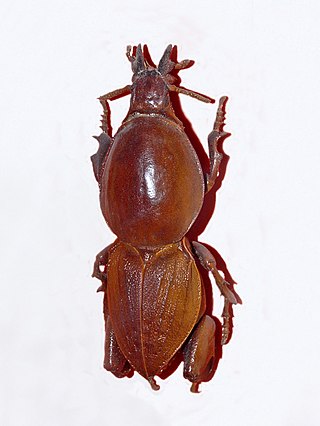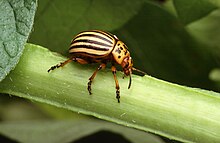
Beetles are insects that form the order Coleoptera, in the superorder Holometabola. Their front pair of wings are hardened into wing-cases, elytra, distinguishing them from most other insects. The Coleoptera, with about 400,000 described species, is the largest of all orders, constituting almost 40% of described insects and 25% of all known animal species; new species are discovered frequently, with estimates suggesting that there are between 0.9 and 2.1 million total species. Found in almost every habitat except the sea and the polar regions, they interact with their ecosystems in several ways: beetles often feed on plants and fungi, break down animal and plant debris, and eat other invertebrates. Some species are serious agricultural pests, such as the Colorado potato beetle, while others such as Coccinellidae eat aphids, scale insects, thrips, and other plant-sucking insects that damage crops. Some others also have unique characteristics, such as the common eastern firefly, which uses a light-emitting organ for mating and communication purposes

Spercheus is a genus of aquatic beetles which are placed in a family of their own, Spercheidae within the Hydrophiloidea. About 20 species are known from around the world except the Nearctic with the majority being from the Oriental and Afrotropical Realms.

Weevils are beetles belonging to the superfamily Curculionoidea, known for their elongated snouts. They are usually small – less than 6 mm in length – and herbivorous. Approximately 97,000 species of weevils are known. They belong to several families, with most of them in the family Curculionidae. It also includes bark beetles, which while morphologically dissimilar to other weevils in lacking the distinctive snout, is a subfamily of Curculionidae. Some other beetles, although not closely related, bear the name "weevil", such as the biscuit weevil, which belongs to the family Ptinidae.

The insects of the beetle family Chrysomelidae are commonly known as leaf beetles, and include over 37,000 species in more than 2,500 genera, making up one of the largest and most commonly encountered of all beetle families. Numerous subfamilies are recognized, but the precise taxonomy and systematics are likely to change with ongoing research.

The longhorn beetles (Cerambycidae), also known as long-horned or longicorns, are a large family of beetles, with over 35,000 species described.

Cucujiformia is an infraorder of polyphagan beetles, representing most plant-eating beetles.

Cleroidea is a small superfamily of beetles containing over 10,000 species. Most of the members of the group are somewhat slender, often with fairly soft, flexible elytra, and typically hairy or scaly.

The flea beetle is a small, jumping beetle of the leaf beetle family (Chrysomelidae), that makes up the tribe Alticini which is part of the subfamily Galerucinae. Historically the flea beetles were classified as their own subfamily.

The Eumolpinae are a subfamily of the leaf beetles, or Chrysomelidae. It is one of the largest subfamilies of leaf beetles, including more than 500 genera and 7000 species. They are oval, and convex in form, and measure up to 10 mm in size. Typical coloration for this subfamily of beetles ranges from bright yellow to dark red. Many species are iridescent or brilliantly metallic blue or green in appearance.

Histeroidea is a superfamily of beetles in the infraorder Staphyliniformia.

Coccinellidae is a widespread family of small beetles. They are commonly known as ladybugs in North America and ladybirds in the United Kingdom; "lady" refers to mother Mary. Entomologists use the names ladybird beetles or lady beetles to avoid confusion with true bugs. The more than 6,000 described species have a global distribution and are found in a variety of habitats. They are oval beetles with a domed back and flat underside. Many of the species have conspicuous aposematic (warning) colours and patterns, such as red with black spots, that warn potential predators that they taste bad.

The Trictenotomidae are a small family of beetles in the superfamily Tenebrionoidea, containing fifteen species in two genera. Most species are found in the Oriental realm where they live in montane forest habitats. The family is considered, based on larval characters as well as sequence-based studies, to be closely related to the Salpingidae.

Colasposoma viridicoeruleum is a species of beetle belonging to the family Chrysomelidae, described by Victor Motschulsky in 1860. It is known as a pest of sweet potatoes. The species was formerly known as Colasposoma auripenne until 2003, when C. auripenne was determined to be a synonym of C. viridicoeruleum. It is sometimes considered a southern subspecies of Colasposoma dauricum, using the name Colasposoma dauricum auripenne.

Hypocephalus armatus, the mole beetle, is a species of beetle in the family Vesperidae. It is the only species in the genus Hypocephalus. Both the genus and species were first described by Anselme Gaëtan Desmarest in 1832. It is found in Brazil and is popular in museums and collections for its curiosity value and adaptations to digging in soil that make them appear outwardly similar to the mole crickets.
Syagrus is a genus of leaf beetles in the subfamily Eumolpinae. They are known from the mainland of Africa. They are often attracted by plants in the family Malvaceae; Syagrus rugifrons and Syagrus calcaratus are pests of cotton. The larvae of Syagrus calcaratus attack the roots of the plant and cause it to wilt.

Coccinelloidea is a superfamily of beetles in the order Coleoptera, formerly included in the superfamily Cucujoidea. There are more than 10,000 species in Coccinelloidea, including more than 6000 in the lady beetle family Coccinellidae.

Eumolpini is a tribe of leaf beetles in the subfamily Eumolpinae. It is the largest tribe in the subfamily, with approximately 170 genera found worldwide. Members of the tribe almost always have a longitudinal median groove on the pygidium, which possibly helps to keep the elytra locked at rest. They also generally have a subglabrous body, as well as appendiculate pretarsal claws.
Phyllotreta liebecki is a species of flea beetle in the family Chrysomelidae. It is found in North America.
Phytophaga is a clade of beetles within the infraorder Cucujiformia consisting of the superfamilies Chrysomeloidea and Curculionoidea that are distinctive in the plant-feeding habit combined with the tarsi being pseudotetramerous or cryptopentamerous, where the fourth tarsal segment is typically greatly reduced or hidden by the third tarsal segment. The Cucujoidea are a sister to the Phytophaga. In some older literature the term Phytophaga was applied only to the Chrysomeloidea.
















